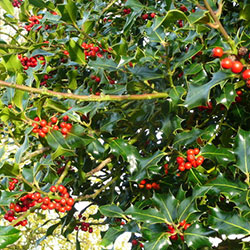Holly is grown for its shiny green, spiny leaves and brightly red berries. In winter, its vibrant green foliage provides forage for deer, and the berries attract  birds.
birds.
Is holly easy to grow in Colorado?
Typical American hollies from eastern U.S., and Chinese hollies, are challenging to grow in Colorado because they prefer a moist soil and acidic, humus- rich soil. Without a lot of soil amentment and extra water, non-native hollies will not grow to full height an may not perform well in Colorado.
What holly’s are best to grow in Colorado?
Only a few hollies are recommended for Colorado if planted in protected sites, but beware that deer browse them heavily in winter. Some hybrid varieties are ‘Blue Boy,’ ‘Blue Girl,’ ‘Blue Prince’ and ‘Blue Princess.’ For these hollies, one male to three female plants must be planted to yield berries.
Native hollies will always flourish better than hollies from other parts of the country. Oregon grape holly and creeping grape holly, the low-growning form, are beatiful all year round: their shiny, spiny, green leaves turn rich burgundy in the fall and remain through the winter; bright yellow flowers delight in spring; fauna enjoy the blue berries. These hollies are tolerant of our alkaline soils, thrive on less water and perform best in partial shade.
For more information, see the following Colorado State University Extension reference materials:
- Trees and Shrubs for Mountain Areas
- Native Shrubs for Colorado Landscapes
- Evergreen Shrubs for Home Grounds
- Selecting Shrubs
- Creeping Grape Holly



